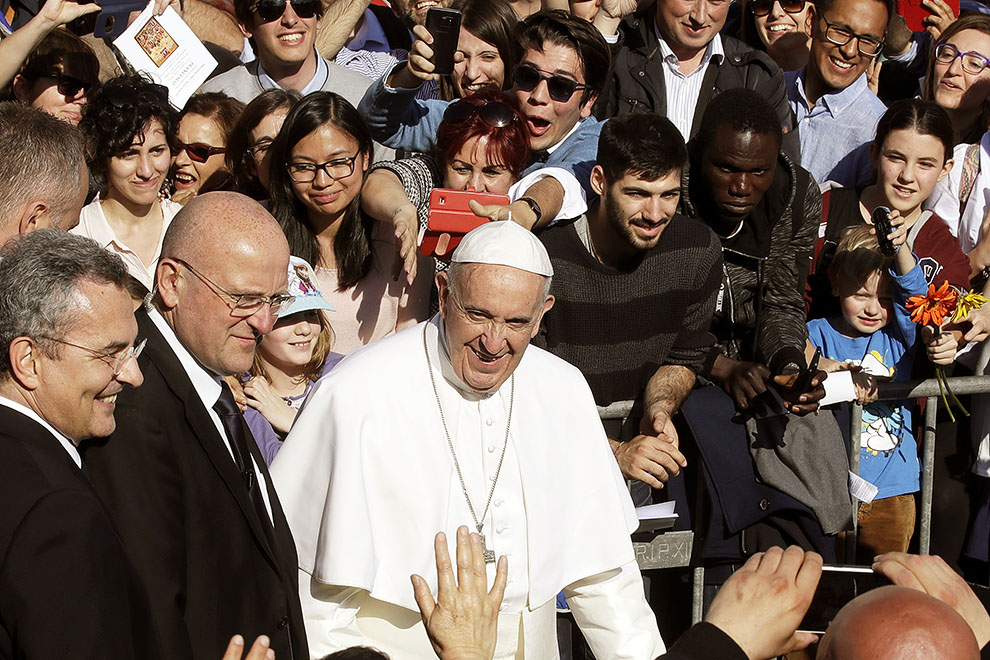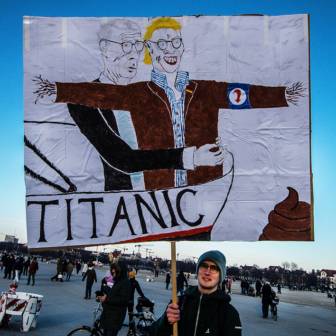“Pope likens migrant holding centres to ‘concentration camps,’” Reuters reported on the weekend. The news received much attention, not least in Israel and Germany.
First responses ranged from bewilderment to ridicule. David Harris of the American Jewish Committee reminded the Pope that “the Nazis and their allies erected and used concentration camps for slave labour and the extermination of millions of people during World War II.” In Australia, Herald Sun columnist Andrew Bolt was also quick to denounce the pontiff. “The Pope really is a fool if he cannot tell the difference between a Nazi concentration camp and a refugee camp,” Bolt sneered.
The Pope made the offending remarks in Rome’s Basilica of St Bartholomew during a service for twentieth and twenty-first century martyrs, including an eighty-five-year-old French priest, Jacques Hamel, who was killed last year by Islamist extremists. During his sermon, the Pope also referred to a Muslim man whose Christian wife had been murdered because she refused to take off her crucifix. He had met the man last year during a visit to a refugee holding centre on the Greek island of Lesvos.
Refugees were not the focus of the Pope’s sermon, and media reports suggest that his written notes didn’t include a reference to concentration camps. The Vatican has, however, made available a transcript of what he said. “I do not know if that man is still in Lesvos or if he has managed to go elsewhere,” Pope Francis said of the man he encountered last year. “I do not know if he was able to get out of that concentration camp.” He immediately offered an explanation for his use of the term: “perché i campi di rifugiati – tanti – sono di concentramento, per la folla di gente che è lasciata lì.” In the Reuters report, that explanation is rather clumsily translated as “because refugee camps, many of them, are of concentration (type) because of the great number of people left there inside them.”
The news agency’s decision to insert an extra word (“type”) to help readers make sense of the Pope’s remarks is an indication of their ambiguity. Did he want to say that refugee camps can be likened to concentration camps because of the number of people accommodated there? Didn’t he rather, as I suspect, realise that his impromptu remark could be misunderstood, and try to backpedal by drawing attention to the fact that the refugees are “concentrated” in holding centres like the one on Lesvos and are not at liberty to leave them? After all, they are being sent back to Turkey under last year’s controversial deal between the government in Ankara and the European Union.
In any case, the quote makes it clear that the Pope did not equate refugee camps with Nazi concentration camps. Having visited Auschwitz-Birkenau last year, he would know that what he saw in Lesvos bore no resemblance to the slave labour and extermination camps associated with the name Auschwitz. But David Harris had a point when he said that “precision of language and facts is absolutely essential when making any historical reference.” Was the pontiff – who, after all, is not a native Italian speaker – not sufficiently attentive to the words he used when he spontaneously referred to concentration camps? Or was he perhaps deliberately careless to provoke a response?
Australians would be familiar with comparisons between concentration camps and camps holding refugees. In 2002, for example, Melbourne artist Juan Davila, who came to Australia in 1974 as a refugee from Pinochet’s Chile, called the Woomera immigration detention facility a “concentration camp.” Two years earlier, one of Australia’s most respected refugee law experts, Sydney University academic Mary Crock, was reported to have said after a visit to the Curtin detention centre that “aspects of the centre resembled a concentration camp.” More recently, the regional processing centres on Manus Island and in Nauru have frequently been likened to concentration camps.
If we take “concentration camp” to mean “Auschwitz,” then such comparisons are extremely problematic. If, however, the intention is to employ the term in a more generic sense, then it is arguably legitimate to use “concentration camp” to draw attention to certain aspects of European holding centres and Australian immigration detention facilities.
According to the New World Encyclopedia, a concentration camp is “a large detention centre created for political opponents, specific ethnic or religious groups, civilians of a critical war-zone, or other groups of people”; imprisonment in such camps is not guided by “due process of law fairly applied by a judiciary.” In the English language, the term was first used during the Cuban war of independence (1895–98) to refer to the reconcentrados, camps set up by the Spanish military to intern Cubans. During the second Boer war (1899–1902), the British established concentration camps to “concentrate” Boer civilians; the term was then widely used in the British press. More than 26,000 women and children died in these camps.
In Germany, the equivalent term, Konzentrationslager, was not pioneered by the Nazis. It was first used in 1904 during the genocidal war against the Herero and Nama in German Southwest Africa to refer to internment camps that were modelled partly on the concentration camps in neighbouring British South Africa. In the early years of the Weimar Republic, concentration camps were set up for short periods to intern non-German Jews and left-wing political prisoners. Thus, when the Nazis came to power and almost immediately set up Konzentrationslager – the Dachau concentration camp commenced operations on 22 March 1933, only seven weeks after Adolf Hitler was appointed German chancellor – neither the term nor the concept was new.
The first Nazi Konzentrationslager were not designed to exterminate large numbers of people. It was not until after the second world war, once the full extent of the Holocaust had become known, that the term “concentration camp” acquired the connotations it has today. These connotations are so specific that they arguably don’t cover the full range of Nazi Konzentrationslager.
In Australia, a government agency still used the term in a generic sense as late as 1940. When Smith’s Weekly complained in November of that year that the Sydney telephone directory listed two internment camps for enemy aliens as “concentration camps,” it was not decrying the use of the term, but outraged at the fact that the Post Office published the camps’ locations while censorship prevented newspapers from revealing such details.
Does this history matter, given that the term concentration camp is now universally associated with Nazi death camps, and particularly with Auschwitz? I believe it does, if it helps to remind us that the concentration of irregular migrants at the so-called hot spots established by the European Union, and the concentration of asylum seekers and refugees in Australian-run immigration detention centres, is not entirely unprecedented.
A year ago, former Court of Appeal judge Stephen Charles QC wrote in the Sydney Morning Herald: “The camps in Manus Island and Nauru have long since ceased to be mere detention centres. They are now concentration camps.” Such an observation could be helpful too. Not because the regional processing facility in Nauru resembles Auschwitz, but because the term “detention centre” may no longer be adequate to describe that facility, in the same way that the term “refugee camp” (which connotes a camp set up to protect and look after refugees) may no longer be an adequate designation for the holding centre on Lesvos.
Charles seems to have had Auschwitz or other death camps in mind when he referred to concentration camps. He wrote that the purpose of the concentration camps in Germany “was to separate various groups – communists, Jews, homosexuals – from the German community.” That was certainly true for the earlier Nazi camps, such as Dachau and Buchenwald. It could be argued that detention centres, too, are such spaces of exclusion.
The pontiff’s impromptu use of the term campo di concentramento may well have been the result of a deep sense of frustration over Europe’s asylum seeker and refugee policies, and the lack of interest in the plight of refugees in much of Europe. He followed his reference to the man he met last year at the holding centre on Lesvos with the observation that “ agreements seem to be more important than human rights.” I suspect the agreements that the Pope had in mind were the 2016 deal between the EU and Turkey and the agreement between the EU and Libya concluded earlier this year. Human rights organisations have condemned both.
It is unlikely that the Pope’s criticism of the European response to refugees and asylum seekers would have been reported if he hadn’t used the term “concentration camp” in the same sermon. And maybe that also justifies his use of the term. At least that’s what Christoph Heubner seems to believe. He is the vice-president of the International Auschwitz Committee, which represents Auschwitz survivors. Heubner did not think the pontiff’s words were inappropriate. “He overdrew to move hearts. That’s legitimate.” Heubner told the German Press Agency.
In last year’s Sydney Morning Herald article, Stephen Charles claimed that the German Konzentrationslager “were maintained in great secrecy; most Germans had little or no knowledge of the awful and dehumanising conditions in which detainees were kept.” This is a myth that many Germans are still fond of repeating. But research has conclusively shown that Charles’s is not an accurate observation. It would be equally untrue to say that Australians have little or no knowledge of the conditions on Manus and in Nauru, or that Europeans have no way of knowing about the conditions in Greek refugee camps (or in the prisons of the European Union’s new best friend, Libya).
And maybe this is the only appropriate comparison between today’s camps and the Nazi concentration camps: today’s Europeans and Australians pretend that they don’t know and bear no responsibility for their governments’ response to refugees and other irregular migrants in the same way that most Germans between 1933 and 1945 pretended the camps had nothing to do with them, and that the best response was to cover one’s eyes and ears.
Pope Francis didn’t say that. But he might have. On more than one occasion, he has condemned what he calls “la globalizzazione dell’indifferenza,” the globalisation of indifference. The attentiveness demanded by David Harris – a “precision of language and facts… when making any historical reference” – is essential indeed. It should also be an attentiveness attuned to etymologies and contested meanings. But even more essential is the kind of attentiveness about whose lack the Pope has been so concerned.




